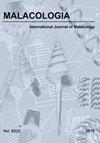印度次大陆近代腹足类杂种捕食及基于修订全球数据库的时空重新评价
IF 0.7
4区 生物学
Q4 ZOOLOGY
引用次数: 9
摘要
捕食者-猎物的相互作用,特别是钻壳和破壳捕食压力,导致了这些捕食者-猎物群落的显著进化变化。虽然猎物组合的时间趋势已经被很好地理解,但直到最近,在分类群中追踪这种变化的研究还很少见。在这里,我们研究了来自印度次大陆的最近的杂交腹足类动物的钻探和破壳捕食,并将结果与最新的全球数据库进行了比较。我们的数据的主要部分来自于加尔各答的印度动物调查档案中保存了100多年的大量收集。本研究基于一个新建立的全球数据库进行了详细分析,结果如下:(1)印度杂交种的钻井频率(DF)较低,但与Vermeij等人(1980)提供的仅有但有限的数据的DF一致。相比之下,印度杂交种的脱皮频率(PF)在世界上最高;(2) DF呈纬向变化,即高纬度地区钻孔发生率较高;PF数据没有出现这种模式;(3)钻孔具有场地定型特征,表明近期酸化钻井升级;(4)贝壳饰品防噬功能不强;(5)壳的形状和厚度对不同捕食方式的影响不同。细长和较厚的壳几乎不受钻孔捕食的影响,而剥皮捕食则不存在这种关系;(6)另一方面,体型似乎在现代杂交品种中进化为反掠食性特征。较大种的DF值较低,PF值较高;(7)时间上DF呈波动型,现代值呈下降趋势。这可能是由于体型的增加和杂交种腹足动物行为的改变。不幸的是,化石记录中没有关于这支进化枝剥落频率的数据。本文章由计算机程序翻译,如有差异,请以英文原文为准。
Predation on Recent Terebrid Gastropods from the Indian Subcontinent and a Spatiotemporal Reappraisal Based on a Revised Global Database
ABSTRACT Predator-prey interaction, especially drilling and shell-breaking predation pressure, caused significant evolutionary changes within these predator-prey communities. Although temporal trends are well understood in prey assemblages, studies to trace such changes within taxonspecific clades up to Recent times have been rare. Here, we studied both the drilling and shell-breaking predation on Recent terebrid gastropods from the Indian subcontinent and compared the results with a newly updated, global database. The major part of our data came from a large collection reposited in the archive of the Zoological Survey of India in Kolkata for more than 100 years. Detailed analyses of this study based on a newly raised, global database revealed the following findings: (1) Drilling frequency (DF) of Indian terebrids was low, but consistent with the DF of only available but limited data provided by Vermeij et al. (1980). In comparison, peeling frequency (PF) in Indian terebrids appeared to be highest in the world; (2) DF showed latitudinal variation, that is, higher incidence of drilling occurred in higher latitudes; no such pattern emerged from the PF data; (3) drillholes were site-stereotyped, which suggested that Recent naticid drillers were escalated; (4) shell ornaments failed to protect against durophagy; (5) shell shape and thickness had different impact against different modes of predation. While slender and thicker shells were almost immune to drilling predation, no such relation existed for peeling predation; (6) on the other hand, body size appears to have evolved as anti-predatory traits in Recent terebrids. Larger species had low DF and high PF values; (7) temporally, DF showed fluctuating pattern, with modern values showing declining trend. This was perhaps due to increase in body size and behavioural change of the terebrid gastropods. Unfortunately, no peeling frequency data for this clade was available from the fossil record.
求助全文
通过发布文献求助,成功后即可免费获取论文全文。
去求助
来源期刊

Malacologia
生物-动物学
CiteScore
2.00
自引率
0.00%
发文量
15
审稿时长
3 months
期刊介绍:
Malacologia publishes papers on all groups of the Mollusca. Malacologia specializes in publishing long papers and monographic treatments. Complete data are especially appreciated. Papers must be of interest to an international readership. Papers in systematics, ecology, population ecology, genetics, molecular genetics, evolution and phylogenetic treatments are especially welcomed. Also welcomed are letters to the editor involving papers published or issues of import to science of the day.
 求助内容:
求助内容: 应助结果提醒方式:
应助结果提醒方式:


